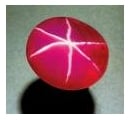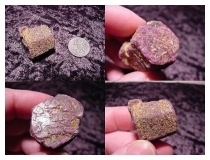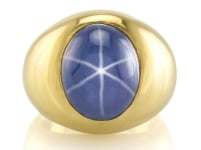Cutting Process of Asteriated Gemstones
Definition of Aterism
 An asterism is an optical phenomenon displayed by some rubies, sapphires, and other gemstones of an enhanced reflective area in the shape of a "star" on the surface of a cabochon cut from the stone. Star sapphires and rubies get their asterism from the titanium dioxide impurities (rutile) present in them.
An asterism is an optical phenomenon displayed by some rubies, sapphires, and other gemstones of an enhanced reflective area in the shape of a "star" on the surface of a cabochon cut from the stone. Star sapphires and rubies get their asterism from the titanium dioxide impurities (rutile) present in them.
Cutting of Asteriated Gemstones: A Challenge
 The cutting of asteriated gemstones is amongst the most challenging tasks a gemstone cutter faces. It is affected by several factors which must be taken into consideration during the cutting & polishing process.
The cutting of asteriated gemstones is amongst the most challenging tasks a gemstone cutter faces. It is affected by several factors which must be taken into consideration during the cutting & polishing process.
A gemstones that displays asterism is always cut en cabochon in order to display the “star effect” However, the star will only appear when the cabochon dome is cut in a certain direction depending on the type of gemstone. For corundum (ruby and sapphire) the cabochon has to be cut with the dome along the c-axis (optic axis) of the stone for it to display asterism. The star effect is displayed due to inclusions (like tubes, silk, etc.) which are parallel to each other.
A star may be four rayed, six rayed, twelve rayed or even more, and it depends upon the number or sets of parallel inclusions in the gemstone. In case of rubies & sapphires, the inclusions of parallel rutile needles are in three sets intersecting each other at 60-120 degree. This forms the three arms of the star which is displayed as a six-ray star.
How to identify Asterism in a gemstone
The identification of asterism is often very difficult. Most of the times it can be seen as sheen on the surface and one has to cut the cabochon in such a way that the sheen is at the center of the dome of the cabochon cut. This forms the star. However, many a times, the parallel sets of inclusions are not clearly visible making it difficult to determine the direction in which the stone needs to be cut. In such cases an ingenuous way of overcoming such a problem is to cut the gemstone in shape of a ball, polish it and then locate the star. Since a ball has an equal radius on all sides, a star will be visible on both sides of the optic axis. After the ball is made and the optic axis is determined, the ball is cut from the center, perpendicular to the optic axis and we get two cabochons that display asterism. However such a method of fashioning causes a greater weight loss and is not recommended for precious gemstones.
Another way, in cases of transparent asteriated gemstones, is to locate the optic axis by help of conoscopy and polariscope and then polish the gemstone in that direction. After the optic axis is located and preshaping is done, the polishing is done.
Star Sharpness
 One of the factors which affects the star formation is the height of the dome. A higher dome causes a fixed and small star on the apex of the dome while a low dome causes a more mobile star and may go off-center.
One of the factors which affects the star formation is the height of the dome. A higher dome causes a fixed and small star on the apex of the dome while a low dome causes a more mobile star and may go off-center.
The centering of a star is very important and an off-centered star is less valued.
Also the strength of the star is dependent on the extent of polishing and on the natural optical character of the stone. For example, a stone with low polish will display a weaker star than a fully polished stone.
The distance between the parallel inclusions too plays a role in the strength of a star. A stone with finely spaced parallel inclusions has a finer star than one with parallel inclusions at a greater distance. When all these factors are considered in unison along with the maximum weight that can be retained, we get our perfect star gemstone.










